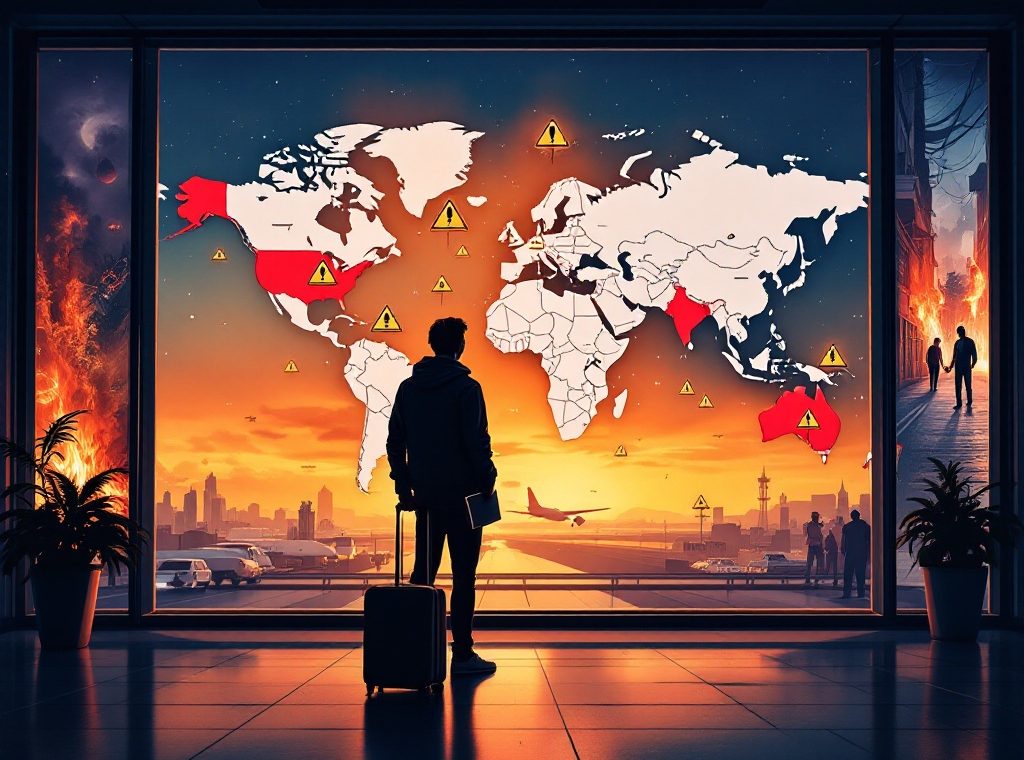What Are the Most Dangerous Countries to Visit
Planning an international trip? Dreaming of exotic locales? Before you book that ticket, discover crucial safety insights. From civil unrest and crime to natural disasters and health risks, this guide reveals the hidden dangers lurking in various countries. Learn how to assess travel risks, prepare for emergencies, and navigate potentially hazardous situations. Empower yourself with knowledge and ensure a safe journey. Read on to travel smart and stay safe.
Important information

- Dangerous countries often have political instability, high crime, limited healthcare, and risks of natural disasters.
- Research your destination: Learn local laws, customs, and safety risks. Check government travel advisories.
- Prioritize health: Research potential diseases, investigate local medical facilities, get travel insurance, and consult your doctor.
- Ensure personal safety: Stay aware, avoid risky areas, secure belongings, share your itinerary, and register with your embassy.
- Prepare for the unexpected: Have a backup plan and readily available emergency contacts. Monitor local news for current events.
Factors That Make a Country Dangerous to Visit
Traveling to politically unstable regions presents inherent risks. Conflict zones create dangerous environments, often marked by civil unrest, terrorism, and war. Personal safety is paramount, as crime, including theft, assault, and kidnapping, can severely impact travelers, particularly visitors. Health is another crucial concern, with potential disease outbreaks, limited healthcare access, and poor sanitation posing substantial risks. Natural disasters, such as earthquakes, hurricanes, and floods, can be devastating, especially in areas with inadequate disaster preparedness. Environmental hazards further compound these dangers. Travelers should carefully consider these risks before embarking on their journeys.
Safety Risks
- Civil unrest, terrorism, and war create volatile and unpredictable conditions.
- Travelers, especially visitors, are vulnerable to crimes like theft, assault, and kidnapping.
Health Risks
- Potential disease outbreaks and limited healthcare access can have severe consequences.
- Poor sanitation increases the risk of illness.
Environmental Risks
- Natural disasters like earthquakes, hurricanes, and floods can be devastating.
- Inadequate disaster preparedness exacerbates the impact of such events.
Other Risks
- Environmental hazards pose additional dangers.
Carefully consider these risks before traveling to politically unstable regions.
Political Instability and Conflict
Traveling to politically unstable regions carries significant risks. These areas often lack basic services and experience escalating violence. Government corruption can lead to unpredictable law enforcement and unreliable judicial processes. Civil unrest, including protests and riots, can disrupt travel plans and endanger personal safety. Ethnic and religious tensions can also escalate into violence, putting visitors at risk. However, you can mitigate these risks.
Understanding the Risks
- Lack of Essential Services: Volatile areas may lack reliable access to healthcare, communication, and transportation, impacting your safety and well-being.
- Escalating Violence: Conflict zones experience unpredictable surges in violence, endangering travelers.
- Government Corruption: Corruption can lead to unreliable law enforcement and judicial systems, hindering your ability to seek assistance.
Mitigating Risks
- Thorough pre-trip research is essential. Consult your government’s travel advisories for up-to-date information on safety and security risks.
- Monitor credible news outlets for current events and potential disruptions.
- Stay informed about local customs and laws to avoid unintentional violations.
Additional Threats
- Civil Unrest: Protests and riots can disrupt travel and pose safety risks.
- Ethnic and Religious Tensions: These tensions can escalate into violence, putting visitors in danger.
Crime Rates and Personal Safety
Crime rates significantly impact personal safety. High rates of violent crimes, such as assault and robbery, increase travel risks, further compounded by homicide statistics. Researching your destination’s crime statistics before any trip is crucial for safe travels. Additionally, taking personal safety precautions, such as avoiding walking alone at night and not displaying expensive jewelry, can significantly enhance your security.
Health Risks and Medical Facilities
Before embarking on your trip, take these important health precautions:
Research potential health risks at your destination, especially infectious diseases. Consulting resources like the Centers for Disease Control and Prevention (CDC) or the World Health Organization (WHO) can provide valuable insights.
Investigate local medical facilities and available health resources. Understanding the quality and accessibility of healthcare at your destination is crucial for a safe trip.
Secure comprehensive travel insurance. This will protect you from unexpected medical expenses and other travel-related issues.
Prepare a well-stocked first-aid kit. Include essential items like bandages, antiseptic wipes, pain relievers, and any personal medications.
Consult your doctor about recommended vaccinations and preventative measures. Discuss your travel plans with your physician to get personalized advice on necessary vaccinations and other health precautions.
Natural Disasters and Environmental Hazards
Traveling comes with inherent risks, especially from natural disasters. Earthquakes, tsunamis, and volcanic eruptions are significant threats, particularly in geologically active zones like the Pacific Ring of Fire. Coastal areas are vulnerable to tsunamis, while regions near active volcanoes face the peril of eruptions and ashfall. Extreme weather, including hurricanes, typhoons, and floods, can also cause widespread destruction and disruption, impacting travelers significantly. So before you go, research potential hazards at your destination and monitor weather alerts. Staying informed is key to staying safe.
What Are Some of the Most Dangerous Countries to Visit?
Traveling to certain countries like Afghanistan, Syria, South Sudan, and Iraq is extremely risky due to the constant threats of terrorism, kidnappings, and widespread violence. Venezuela and Honduras also pose significant dangers because of their extremely high crime rates. Active conflicts turn places like Ukraine and Yemen into volatile war zones. Furthermore, natural disasters are a serious concern, particularly in countries like the Philippines and Indonesia.
Risky destinations due to violence and crime
- Afghanistan,
- Syria,
- South Sudan,
- Iraq,
- Venezuela,
- Honduras.
Risky destinations due to conflict and natural disasters
- Ukraine,
- Yemen,
- the Philippines,
- Indonesia.
Before traveling anywhere, especially to higher-risk destinations, always consult travel advisories from reliable sources. This crucial information empowers you to make informed decisions and prioritize your safety.
Countries with High Crime Rates
Venezuela is plagued by high crime, including kidnappings, robberies, and murders. South Africa also grapples with elevated crime rates, where carjacking and armed robbery pose significant threats. Honduras, gang violence and drug trafficking contribute to a tragically high murder rate. El Salvador, too, suffers from rampant crime, largely fueled by gang activity.
Papua New Guinea faces widespread tribal violence and theft. Afghanistan remains dangerous due to ongoing conflict, terrorism, and rampant crime. Syria, ravaged by civil war, is a place of pervasive violence and danger. South Sudan is yet another nation struggling with conflict and high crime. Iraq is marked by terrorism, instability, and widespread criminal activity.
Regions with Active Conflict or War
Traveling to active war zones such as Afghanistan, Syria, South Sudan, Iraq, and Ukraine is extremely dangerous. These regions present substantial risks to travelers, including terrorism, kidnapping, and violence. Ongoing military operations and political instability significantly contribute to the danger, making travel to these areas highly inadvisable.
Areas Prone to Natural Disasters
The Ring of Fire, a zone notorious for earthquakes and volcanic activity, wraps around the Pacific Ocean, impacting nations like Japan, Indonesia, and the Philippines. Coastal communities worldwide also face various threats. For example, areas in the Caribbean and Southeast Asia grapple with hurricanes and typhoons. Low-lying areas like Bangladesh face recurrent flooding. Regions near fault lines, such as California, are susceptible to earthquakes.
How to Stay Safe When Visiting Dangerous Countries
Traveling to a destination with safety concerns requires thorough research. Explore local laws and customs, and understand potential risks. Use government travel advisories from reliable sources for essential safety updates. Upon arrival, register with your embassy for emergency assistance. Stay informed about local news and official alerts to adapt to changing situations. Choose safe transportation, avoid risky areas, and maintain a low profile while staying aware of your surroundings. Prepare a backup plan and keep emergency contacts readily available.
Research your destination thoroughly. Learn about local laws, customs, and potential safety risks.
Consult government travel advisories. Use reliable sources for essential safety updates and heed any warnings or precautions.
Register with your embassy upon arrival. This enables them to provide assistance in case of emergencies.
Stay informed. Monitor local news and official alerts for any changes in the security situation.
Prioritize safe transportation. Choose reputable providers and avoid risky areas or modes of transport.
Maintain a low profile and be aware of your surroundings. Avoid drawing unnecessary attention to yourself and stay vigilant about your environment.
Have a backup plan. Prepare for unexpected events and have alternative arrangements in place.
Keep emergency contacts readily available. Ensure you have easy access to important numbers in case of need.
Research and Planning Before Travel
Before embarking on any journey, thorough research is essential. Familiarize yourself with local laws and customs, and understand potential safety risks. Effective planning is also crucial. Develop a detailed itinerary, secure safe accommodations and transportation, and consult government travel advisories for the latest updates on your destination. These preparations mitigate risks and significantly enhance your travel safety, ensuring a more informed and secure trip. Here’s a breakdown of essential travel preparations:
Research your destination. Learn about local laws, customs, and potential safety risks.
Plan your itinerary. Create a detailed plan outlining your activities, accommodations, and transportation.
Secure safe accommodations and transportation. Choose reputable and secure options for your stay and travel within your destination.
Check government travel advisories. Stay informed about the latest updates and potential risks associated with your destination.
Staying Informed About Current Events
Staying informed is crucial for safe travels. Check reliable news sources, including government travel advisories and local news, for valuable safety insights. These resources offer updates on potential travel disruptions, such as political instability, protests, health outbreaks, and natural disasters. Being aware of these risks helps ensure your safety.
Safety Measures and Precautions
Be mindful of your surroundings and avoid displaying expensive jewelry or electronics.
Stick to well-lit and busy areas, especially after dark.
Solo travelers should share their itinerary with a trusted friend or family member.
Before you go, research your destination, including local laws and customs.
Upon arrival, register with your embassy or consulate.
Opt for safe transportation options, such as reputable taxis or well-known ride-sharing services.
Secure your belongings by keeping valuables out of sight and carrying copies of important documents separately from the originals.
Learning basic self-defense can also be beneficial.
Keep emergency contacts readily available.
Consider travel insurance for coverage of medical emergencies and evacuations.
Finally, trust your instincts; if a situation feels unsafe, remove yourself.
















